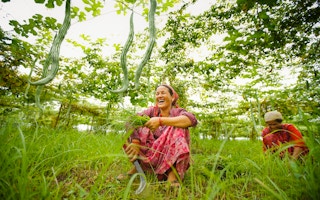Put women in charge of cultivating forests and the trees grow stronger. That’s the takeaway from a pioneering 30-year scheme that has elevated women to the top of Nepal’s community forests - and paved their way into local and national politics.
Three decades of picking women for leadership roles has produced healthier forests and happier workers, according to Nabaraj Pudasaini, joint secretary of the government’s Department of Forest and Soil Conservation.
“In comparison to other community forests in the country, the ones managed by women are doing exceptionally well,” said Pudasaini.
“Women spend more time in the forest than men, so they naturally have a deeper love and understanding of it. They are honest, transparent and have good relations with villagers, so they became a success,” he added.
Apsara Chapagain is typical of this trend for top female foresters, as the first women to chair the Federation of Community Forestry Users Nepal (FECOFUN), a national body that promotes community rights over local land.
With tropical and temperate forests covering about 40 per cent of the Himalayan nation, the health of its trees is key to Nepal’s prosperity and its roughly 29 million people.
Having run FECOFUN from 2010 to 2015, Chapagain is now deputy speaker of the assembly in Bagmati province, one of seven in the landlocked nation.
The 51-year-old credits her rise in local politics to her pioneering work with protecting trees and championing women.
“We have worked to show the way for the state,” said Chapagain, whose time with the forest movement taught her how to run teams, chair meetings and take decisions for the benefit of the community at large.
“Any institution of the state cannot ignore FECOFUN’s contribution,” she added.
From forest conservation to political leadership
Nepal’s community forests were set up in 1995 to use land more sustainably and help reduce local poverty.
The country’s forested area has since increased to about 44 per cent from 29 per cent, according to the Ministry of Forest and Environment.
FECOFUN now represents 3 million Nepalis working the forests in about 22,415 groups. Of those, 1,000 groups are female-led, and the rest are split equally by gender.
Popular Gentle, an expert in community forestry, said FECOFUN was a pioneer in Nepal in ensuring the equal representation of women, ethnic groups and every caste.
“
Women spend more time in the forest than men, so they naturally have a deeper love and understanding of it. They are honest, transparent and have good relations with villagers, so they became a success.
Nabaraj Pudasaini, joint secretary, Department of Forest and Soil Conservation
He said the Nepali government had watched its success and followed suit, incorporating FECOFUN’s policy to ensure that women take a third of roles running all aspects of the state.
FECOFUN was still more ambitious, safeguarding half of its jobs for women in a groundbreaking provision that began in 1996 and propelled many women into mainstream politics today.
Bharati Pathak, who stood down as chair of FECOFUN last month, said the programme “has enabled female participation and empowerment for women who could not come out from home”.
Nepali society is male-dominated, with women largely confined to caring for family and home. Nearly 29 per cent of women are economically active - compared with about 53 per cent of men - and female workers are much more likely than their male counterparts to be in precarious employment, according to World Bank data.
Pathak - who has spent 15 years on FECOFUN’s central committee - has been treasurer, general secretary and president.
Now serving as a member of the Bagmati assembly, she is one of a group of forestry trailblazers turned politicians.
In last November’s election, more than 40 community forest campaigners - 30 of them women - won seats in the House of Representatives and the seven provincial assemblies in Nepal.
Overall, female representation in state and national politics stands at 33 per cent.
Women in charge
Women are vital to the cultivation and preservation of Nepal’s forests - and also key to fostering greater inclusion across state institutions, said Sindhu Dhungana, joint secretary of the Ministry of Forest and Environment.
“Nepal’s community forestry programme can serve as a model for the world,” said Dhungana, whose ministry oversees the Department of Forest and Soil Conservation.
He praised women’s role in conservation efforts, saying they had planted trees, stopped grazing, fenced forests and educated villagers about land preservation.
One such woman, Nanda Kuwar, has chaired the Madhumalati community forest in Kailali in western Nepal since 2014.
When the 50-year-old took over, the forest was sparse, and the land was under direct threat from construction, cattle-grazing and farming.
Kuwar’s first task was to launch a campaign to get the community planting more vegetation in the forest - an initiative that opened her to attack by a developer armed with a sickle.
“Blood was flowing from my hand, and I immediately went to the hospital,” she recalled.
“Now there is greenery and big trees. Seeing the trees of my community forest makes me forget my pain.”
Meanwhile, the Buddha Mangal Tal Women Community Forest in Nawalparasi district in the country’s midwest has been hailed as a beacon of environmental rescue led by women.
Encroachment by villagers who cultivated paddy and reared cows had been a blight on the forest - and when local men failed to stop it, the women stepped up and took charge, said Kamal Pariyar, chairperson of FECOFUN in Nawalparasi.
A committee was established - managed by women - which fenced off the area and planted trees. Visitors to the forest must buy tickets, with the proceeds going towards poorer families, prioritising female-led households.
“When the women took over leadership 15 years ago, they put a stop to encroachment,” said Pariyar. “They made sure that every household understood the importance of the forest.”
This story was published with permission from Thomson Reuters Foundation, the charitable arm of Thomson Reuters, that covers humanitarian news, climate change, resilience, women’s rights, trafficking and property rights. Visit https://www.context.news/.

















